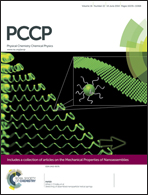Long-term self-assembly of inorganic layered materials influenced by the local states of the interlayer cations
Abstract
A wide variety of parameters as, e.g., temperature, humidity, particle size, and cation state are known to influence the agglomeration process of two-dimensional (2D) nanosheets, called self-assembly, in inorganic layered materials. The detailed studies on which parameters are decisive and how they influence the self-assembly, however, have not been performed yet. Here, the long-term self-assembly was studied for layered stevensite and hectorite, and compared with our previous data of saponite for elucidating an influence of local states of the interlayer cations. The results were analyzed with respect to a recently established rheological model, in which 2D nanosheets migrate parallel to the layer direction aided by water molecules as lubricants [K. Sato et al., J. Phys. Chem. C, 2012, 116, 22954]. With decreasing the strength of the local electric fields facing to the interlayer spaces, cation positions split into two or three, which makes the distribution of water molecules more uniformly. These water molecules enhance the rheological motion of the 2D nanosheets parallel to the layer direction, thus accelerating the self-assembly process.


 Please wait while we load your content...
Please wait while we load your content...